Is Your Mexico Factory Struggling with Border Trade Packaging Compliance and Traceability? Try a Pallet Changing Machine
Are you running a steel mill or a large manufacturing facility in Mexico? You probably know the constant pressure of moving products across the border. A shipment gets delayed in Laredo or Tijuana. The reason? A broken wooden pallet or one that doesn't meet international standards. This small detail can cause huge problems. It leads to costly delays, potential fines, and unhappy customers in the US. You work hard to produce high-quality goods. But your efforts are undermined by the final step: the pallet it sits on. This frustration is a major roadblock to smooth, profitable trade.
Yes, a pallet changing machine can solve these struggles. It directly addresses packaging compliance and traceability issues for factories in Mexico. The machine allows you to transfer your goods from an internal, reusable pallet to a new, export-compliant one right before shipment. This simple switch ensures you meet all border trade regulations, like ISPM 15 for wood packaging. It also provides a perfect opportunity to log the final pallet and load data, creating a clear and traceable record for every single shipment. This eliminates compliance-related rejections and delays at the border.
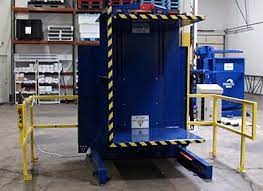
I've spent over 25 years in the packaging machine industry, first as an engineer and now as a factory owner myself. I have seen these challenges firsthand. I understand that for a CEO like you, every piece of equipment must be more than just a machine. It must be a solution. A pallet changer is exactly that. It's not just about swapping pallets. It's about gaining control over your logistics, cutting hidden costs, and building a more resilient supply chain. Let's explore how this single piece of equipment can address some of the biggest challenges you face every day.
How Can a Pallet Changer Tackle Rising Energy and Maintenance Costs?
Does it feel like your energy and maintenance bills are constantly climbing? You see forklifts running all day, moving goods, and sometimes just restacking them from one pallet to another. This manual process consumes a lot of fuel and electricity. It also puts heavy strain on your equipment, leading to more frequent breakdowns and higher repair costs. You know that these small, repeated inefficiencies add up to a significant financial drain, directly impacting the profitability you work so hard to protect.
A pallet changing machine tackles these costs by automating a highly inefficient process. It dramatically reduces the need for forklifts to perform slow, manual restacking. This directly lowers fuel consumption and frees up your material handling equipment for more productive tasks. Modern pallet changers are also engineered for energy efficiency, using optimized hydraulic or electric systems that consume minimal power per cycle. This automation reduces wear and tear not only on the changer itself but also on your fleet of forklifts, extending their service life and cutting down on maintenance expenses.
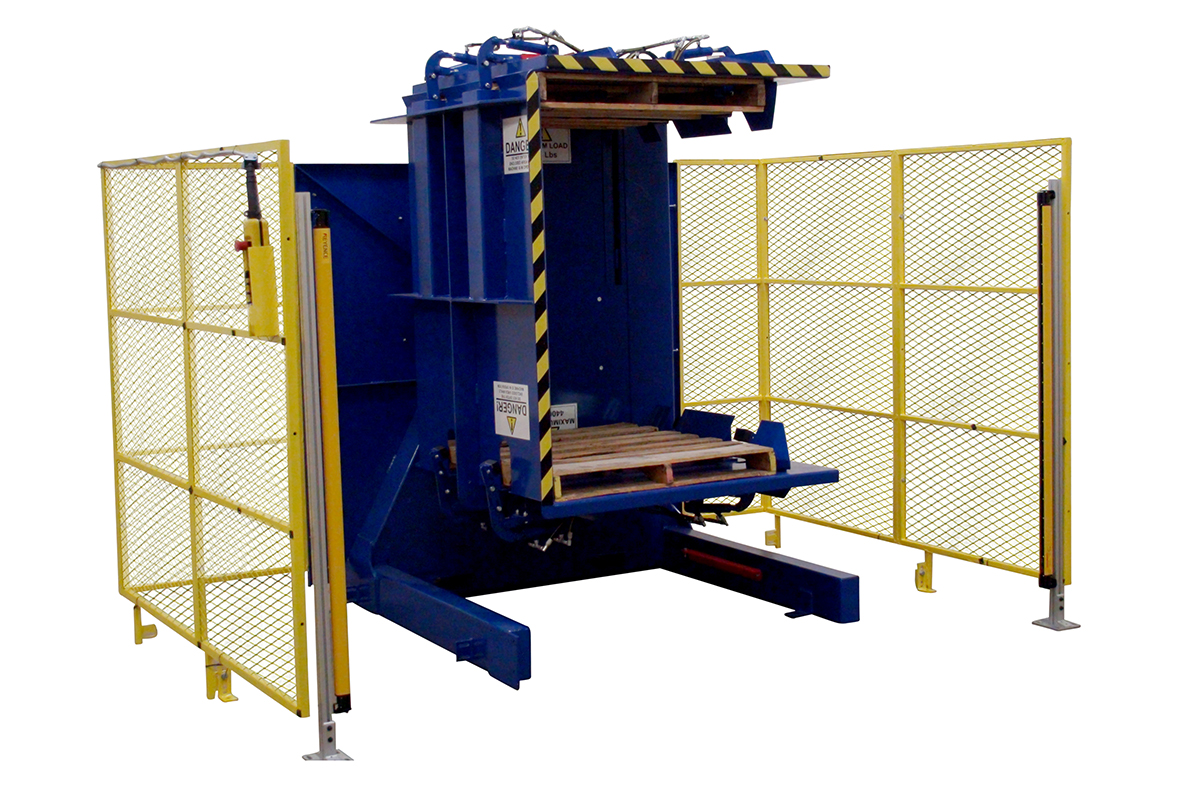
A Deeper Look at Operational Cost Reduction
For a practical business owner, the numbers have to make sense. Let's break down how a pallet changer directly impacts your operational expenditures (OPEX). The savings come from two main areas: direct energy use and indirect maintenance costs. Manually changing a pallet is a surprisingly resource-intensive task. It often requires two forklifts or one forklift and several workers. The process is slow, meaning engines are idling and consuming fuel without doing productive work.
Automating this process creates immediate, measurable gains. A pallet changer completes a cycle in a minute or two, using a fraction of the energy a forklift would burn in the 15-20 minutes it might take to do the same job manually. Think about the cumulative effect over hundreds of shipments per week.
| Metric | Manual Pallet Change (Estimate) | Automated Pallet Changer (Estimate) | Impact |
|---|---|---|---|
| Time per Pallet | 15 - 20 minutes | 1 - 2 minutes | 90% Time Reduction |
| Labor Required | 1-2 workers + 1 forklift operator | 1 operator (part-time) | Reduced Labor Cost |
| Forklift Fuel/Energy | High (idling and maneuvering) | Very Low (machine's efficient motor) | Significant Fuel/Energy Savings |
| Risk of Product Damage | Moderate to High | Very Low | Reduced Spoilage/Waste Costs |
Lowering Maintenance on Your Core Fleet
One of the hidden costs of manual pallet handling is the accelerated wear on your aging equipment. Every time a forklift lifts, tilts, and carefully maneuvers to allow workers to restack a load, it puts stress on its hydraulic system, mast, tires, and engine. For a steel mill with heavy loads, this stress is magnified.
A pallet changing machine isolates this task. Your forklifts do what they do best: transport loads from Point A to Point B. They simply place the load in the pallet changer and retrieve it a minute later on a new pallet. This simple change in workflow can significantly extend the life of your material handling fleet. It reduces engine hours, minimizes stress on hydraulic pumps, and decreases tire wear. For a factory owner managing a 15-year-old fleet, this means fewer breakdowns, lower spare parts costs, and pushing back major capital investment in new forklifts. It directly supports the goal of increasing equipment uptime and reducing the maintenance budget.
Can a Pallet Changer Help Meet Mexico's Strict Environmental and Trade Regulations?
Are you constantly worried about international shipping rules? Exporting from Mexico to the United States or Europe means navigating a complex web of regulations. The most common headache is ISPM 15, which governs wood packaging material to prevent the spread of pests. A single non-compliant wooden pallet can get your entire shipment quarantined, causing massive delays and potential financial penalties. This regulatory pressure adds another layer of complexity to your operations, forcing you to choose between costly compliant pallets for all uses or risking non-compliance at the border.
Yes, a pallet changer is a powerful tool for meeting these strict regulations. It creates a clear, controlled point in your process to ensure 100% compliance. You can use durable, low-cost internal pallets for all your in-factory storage and movement. Then, just before loading for export, you use the pallet changer to swiftly move the goods onto a certified, ISPM 15-stamped wooden pallet or a clean plastic pallet. This strategy, known as a "pallet transfer program," eliminates the risk of non-compliance. It also supports your environmental goals by allowing you to reuse internal pallets endlessly, reducing wood consumption and waste.
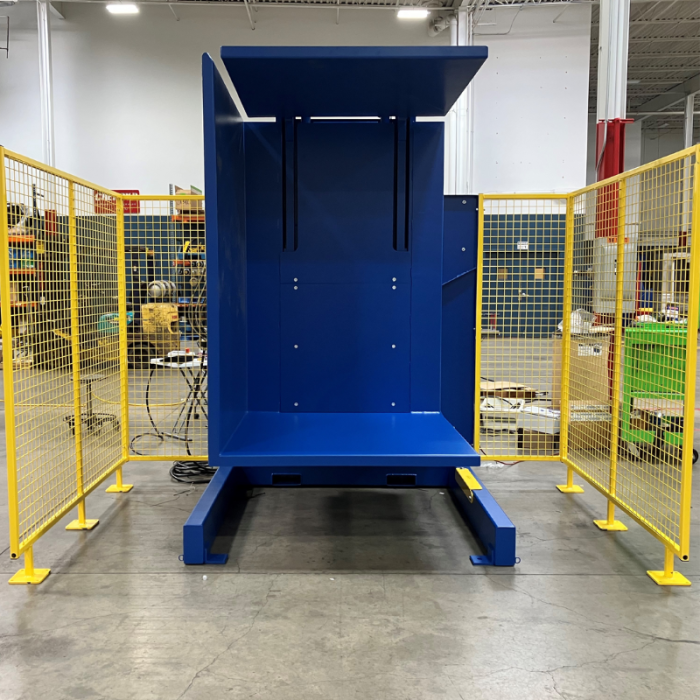
Mastering Border Trade and ISPM 15 Compliance
For any business in Mexico involved in exporting, understanding and mastering ISPM 15 is not optional. This international standard requires that all wood packaging material, including pallets, be heat-treated or fumigated to kill insects and pests. Proof of treatment is indicated by an official stamp on the pallet. U.S. Customs and Border Protection (CBP) agents actively inspect for this.
Without a pallet changer, you have two bad options. Option one is to use expensive, ISPM 15-compliant pallets for everything in your plant. This means these valuable pallets get damaged in the warehouse, worn down during production, and often lost internally. Option two is to risk using non-compliant pallets and hope they don't get inspected. This is not a strategy; it's a gamble. A rejected shipment can cost thousands of dollars in storage, re-palletizing fees, and transportation, not to mention the damage to your reputation with the customer.
A pallet changing machine provides the perfect strategic solution. It physically separates your internal logistics from your export logistics.
Building a Sustainable and Efficient Pallet Program
Beyond just compliance, a pallet changer supports a more sustainable and cost-effective operational model. Many forward-thinking companies are moving towards a circular economy model within their factories. This means using high-quality, durable plastic or composite pallets for all internal movements. These pallets can last for years, drastically reducing the waste and cost associated with disposable wooden pallets.
However, your customers may require shipments on standard wooden pallets. A pallet changer bridges this gap perfectly.
| Stage of Logistics | Without Pallet Changer | With Pallet Changer | Benefit of a Pallet Changer |
|---|---|---|---|
| Internal Storage | Uses ISPM 15 wood pallets, which get damaged. | Uses durable, reusable plastic pallets. | Reduces cost and waste. |
| Production Line | Risk of contamination/damage to export pallet. | Product stays on clean, internal pallet. | Protects final packaging integrity. |
| Pre-Shipping | Manual check, hoping pallet is compliant/undamaged. | Automated transfer to a new, compliant pallet. | 100% Guaranteed Compliance. |
| Environmental Impact | High wood consumption and waste. | Minimal waste, promotes pallet reuse. | Supports corporate sustainability goals. |
This system not only solves the regulatory problem but also aligns with goals to reduce operational costs and environmental impact. It turns your pallet inventory from a disposable expense into a reusable asset, a smart move for any cost-conscious and forward-thinking factory owner.
How Does a Pallet Changer Adapt to Fluctuating Demand and Non-Standard Loads?
Does your production schedule feel unpredictable? One week you're shipping to a customer who needs standard CHEP pallets, the next week a different customer demands their own specific pallet type. In the steel industry, you're not just dealing with boxes; you're handling heavy coils, spools of wire, or irregularly shaped metal parts. Trying to manually transfer a 10-ton steel coil from one pallet to another is not just inefficient, it's extremely dangerous. This lack of flexibility can create bottlenecks in your shipping department, making it hard to respond quickly to market changes and customer requests.
A pallet changer is designed for this kind of versatility. It provides the flexibility to adapt to various load types and fluctuating demands on the fly. Whether you need to switch from an in-house pallet to a customer-specified one, or from a wooden pallet to a plastic one, the machine handles it in minutes. Specialized pallet inverters, a type of changer, are built to securely clamp and rotate heavy, unstable loads like steel coils. This capability allows your factory to be agile, meeting any customer's packaging requirement without dangerous manual handling or time-consuming production stops.
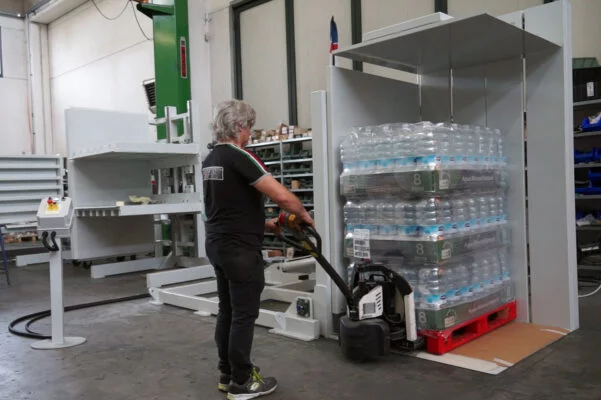
Mastering Heavy and Irregular Loads
Standard pallet changers are great for boxed goods, but the steel industry presents unique challenges. Products are often heavy, dense, and have a high center of gravity. A steel coil, for example, is inherently unstable. Manually handling these products during pallet exchange is a major safety risk and a common source of product damage.
This is where a specific type of machine, the pallet inverter, becomes essential. Unlike a push-pull changer, an inverter clamps the entire load (pallet and all), rotates it 180 degrees, and allows the original pallet to be removed from the top. Then, the new pallet is placed on top, and the load is rotated back. This process keeps the product stack secure and stable at all times.
| Load Type | Manual Handling Challenge | Pallet Inverter Solution | Benefit |
|---|---|---|---|
| Steel Coils | High risk of tipping, requires special C-hooks. | Securely clamps the coil and pallet together. | Total safety and stability. |
| Wire Spools | Awkward shape, prone to rolling. | Adjustable clamping pressure holds the spool firmly. | Prevents product movement/damage. |
| Stacked Metal Sheets | Can shift and slide, causing injury or damage. | Even pressure across the top and bottom. | Maintains stack integrity. |
| Heavy Machinery Parts | Irregular shape, difficult to secure. | Customized clamping jaws can adapt to shape. | Handles complex loads easily. |
By investing in the right type of pallet changer for your specific products, you transform a dangerous bottleneck into a safe, efficient, and repeatable process. This directly contributes to your goal of improving产能利用率 (capacity utilization) by ensuring the final packaging step can keep up with production.
Building Agility into Your Outbound Logistics
Market demand is never stable. A successful factory must be able to pivot quickly. A pallet changer is a key enabler of this agility. Imagine a rush order comes in from a major automotive client. They require all shipments to be on their specific, RFID-tagged plastic pallets. Without a pallet changer, this would mean a major disruption. You would have to manually break down and restack dozens of loads, a process that could take an entire shift.
With a pallet changer, this is a minor logistical adjustment. Your team continues to produce and stage products on standard internal pallets. As the truck for that specific customer arrives, the loads are quickly run through the pallet changer to meet the unique requirement. There is no production slowdown, no dangerous manual labor, and no missed shipping deadlines. This ability to say "yes" to any customer's logistical requirement is a powerful competitive advantage. It allows you to be a more flexible and reliable partner, which is essential for long-term business growth.
What Digital Integration and Customization Options Future-Proof a Pallet Changer Investment?
When you invest in new equipment, are you thinking about how it will fit into your factory in five or ten years? A machine that works today but cannot connect to your future systems can quickly become obsolete. You are pushing for a digital transformation with MES and IoT platforms. A standalone machine that requires manual data entry for traceability or cannot be adjusted for new product lines creates an "island of automation." It doesn't contribute to your vision of a fully connected, smart factory.
To future-proof your investment, a modern pallet changer must be built for integration and customization. The best machines are not just mechanical workhorses; they are intelligent data points in your production line. They should offer seamless connectivity to your MES and ERP systems, allowing for automatic data logging that enhances traceability. They can be equipped with IoT sensors to enable predictive maintenance. Furthermore, they should be customizable in their design—from clamping pressure to safety features—to ensure they can adapt as your products and processes evolve.
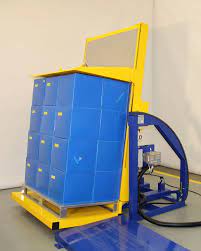
Creating a Connected Factory with MES/ERP Integration
Traceability is critical for border trade and quality control. A pallet changer with digital integration can become a key part of your traceability system. When a load enters the machine, a barcode scanner can read the product information from the old pallet or work order. When the new, export-ready pallet is put in place, its unique barcode or RFID tag is also scanned.
The machine's controller then instantly communicates this data pairing to your Manufacturing Execution System (MES) or Enterprise Resource Planning (ERP) system. The system now knows that Product_Lot_ABC is on Export_Pallet_XYZ. This creates a perfect, error-free digital record. This automated data capture eliminates manual entry errors and provides the instant traceability required by many international customers and regulatory bodies. It’s a foundational step in achieving the comprehensive production visualization you're aiming for.
Customization and IoT for Maximum Uptime and Flexibility
No two factories are exactly alike. A "one-size-fits-all" machine rarely fits perfectly. True strategic equipment partners understand this and offer customization. For a steel mill, this could mean:
| Customization Feature | Standard Machine | Customized Machine | Benefit for a Steel Mill |
|---|---|---|---|
| Clamping Pressure | Fixed or limited range. | Fully adjustable, sensor-controlled pressure. | Safely handles both heavy steel and wrapped, sensitive products. |
| Machine Footprint | Standard size. | Designed to fit into a specific, tight space in the line. | Optimizes factory floor layout. |
| Safety Systems | Basic light curtains. | Area laser scanners, fencing, and automated doors integrated with factory E-stop system. | Enhanced worker safety, exceeding compliance standards. |
| Controls | Basic push-button. | HMI screen integrated with your MES, showing production data. | Aligns with digital transformation goals. |
Furthermore, embedding IoT sensors for predictive maintenance directly supports your goal of achieving 95% equipment uptime. These sensors can monitor hydraulic pressure, motor temperature, and cycle counts. This data can predict a potential failure before it happens, allowing your maintenance team to schedule repairs during planned downtime. Instead of reacting to costly breakdowns, you are proactively managing the health of your equipment. This is the essence of a smart, future-proofed factory.
My Insights: Beyond the Machine - Choosing a True Partner for Your Steel Mill's Success
I remember a time, early in my career running my own factory, when a major shipment to a European client was rejected. It wasn't because of the product quality, which was perfect. It was because the wooden pallets we used had absorbed moisture and warped slightly during the sea journey. The client's automated warehouse couldn't handle them. It was a painful and expensive lesson. We had to pay to have the entire shipment sent to a third-party facility in Europe to be manually re-palletized. That single incident cost us tens of thousands of dollars and, more importantly, it damaged the trust we had built with a key customer.
That experience taught me that the package is part of the product. And the equipment that handles that package is part of your promise to the customer. When I read about your challenges and goals, Javier, I see a leader who understands this. You're not just looking for a machine vendor; you are looking for a strategic partner who can provide a total solution. That is precisely the philosophy I built SHJLPACK on. A pallet changer is an excellent piece of equipment, but its true value is only unlocked when it's integrated thoughtfully into your unique operation.
A partner doesn't just sell you a machine. A partner asks about your energy costs and recommends an energy-efficient electric model over a hydraulic one. A partner discusses your ISPM 15 compliance struggles and shows you how an integrated scanner can automate your traceability. A partner learns about your heavy steel coils and designs a pallet inverter with the right clamping pressure and safety features. They help you connect the machine to your MES system and provide the support to ensure it helps you reach your goal of 95% uptime. The machine is the tool, but the expertise and partnership are what solve the problem. You've built your success by being a forward-thinking entrepreneur. Your choice in equipment partners should reflect that same strategic vision.
Conclusion
A pallet changing machine solves Mexico's border compliance and traceability issues while boosting efficiency, cutting costs, and future-proofing your factory's operations. It is a strategic investment in operational excellence.





